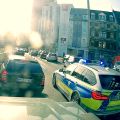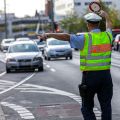While it is often a matter of life and death for the victims, "rubberneckers" only have one goal: "Hollywood-ready" photos and videos! They use their smartphones to take photos and videos of serious road accidents out of sensationalism and then make themselves important to others on the internet or on Facebook - at the expense and to the detriment of the victims! Interior Minister Herbert Reul takes a clear stance: "This is voyeurism in its worst form". Because instead of helping, their behavior hinders rescue workers in their life-saving work and causes dangerous situations. For example, rubberneckers repeatedly cause dangerous situations and traffic jams on highways by driving slowly and braking abruptly. However, rubberneckers should always be aware of how quickly they themselves can become victims and how important it is for them to get help quickly.
Social media film "Onlookers - Don't be a rubbernecker"
The three-minute social media film "Onlookers - Don't be a rubbernecker" aims to set an example against reckless "rubberneckers". A group of young adults drive past a fire department responding to a serious traffic accident. They get out of the car to take a closer look at the accident and take photos, which they then post on the internet. See here what happens next.
"Gawkers" to be punished more severely
The NRW police consistently prosecute the illegal behavior of "gawkers", provided the emergency situation allows it. One cautionary example is a serious accident on the A 3 near Ratingen on November 16, 2017, in which three people lost their lives. The officers initiated investigations against 92 "rubberneckers". Another negative example is a serious traffic accident on the A44 in 2018, where police officers filed criminal charges against six suspects.
Unpleasant scenes occur time and again on North Rhine-Westphalia's roads. The Road Traffic Regulations (StVO) do not qualify "rubbernecking" as an offense punishable by a fine. According to the StVO, only the use of smartphones while driving is prohibited. It does not matter whether you are making a phone call or filming with your cell phone. In contrast, § 201a of the German Criminal Code (StGB), which was revised on January 27, 2015, now also makes the production and distribution of images that show the helplessness of other people and thus violate the highly personal sphere of the person depicted punishable by up to two years' imprisonment.
A Federal Council resolution initiated by NRW on March 2, 2018 extended the scope of application of Section 201a StGB with regard to "gawkers" at accident scenes to include deceased persons. From January 1, 2021, it will be a punishable offence to photograph, film or share images with third parties that show a deceased person in a grossly offensive manner. Gawkers face a fine or a prison sentence of up to two years.
Rescue lanes save lives
By driving slowly and braking abruptly, rubberneckers repeatedly cause dangerous situations and traffic jams on freeways. But everyone can help and form an emergency lane. Rescue lanes save lives! They enable the emergency services to get to the scene of an accident quickly to rescue and treat injured people. And every second counts.
A lane must be formed between the leftmost lane and the lane immediately to the right. The principle is very easy to remember with your right hand: The gap between your thumb and index finger is the emergency lane.
You can see how to form an emergency lane quickly and correctly here in the video.

